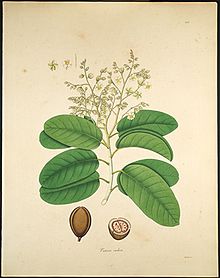Vateria indica
Appearance
| Vateria indica | |
|---|---|

| |
| Vateria indica illustration | |
| Scientific classification | |
| Kingdom: | Plantae |
| Clade: | Tracheophytes |
| Clade: | Angiosperms |
| Clade: | Eudicots |
| Clade: | Rosids |
| Order: | Malvales |
| Family: | Dipterocarpaceae |
| Genus: | Vateria |
| Species: | V. indica
|
| Binomial name | |
| Vateria indica | |
| Synonyms | |
| |
Vateria indica, the white dammar,[2] is a species of plant in the family Dipterocarpaceae. It is endemic to India. It is threatened by habitat loss. This tree grows like a palm but has blunt thorns along its trunk.




Uses
The resin, also called white dammar, is extracted by scratching the tree's bark. It is used as incense in India, and as an Ayurvedic medicine.[citation needed] Vateria indica oil is produced from the seeds.
Chemical constituents
Some stilbenoids[which?] in resins from V. indica have been shown to have some in vitro anti-tumor effects in high doses when isolated from the plant.[3]
References
- ^ Dhyani, A.; Barstow, M. (2020). "Vateria indica". IUCN Red List of Threatened Species. 2020. Retrieved 16 May 2020.
{{cite journal}}: Invalid|ref=harv(help) - ^ USDA, NRCS (n.d.). "Vateria indica". The PLANTS Database (plants.usda.gov). Greensboro, North Carolina: National Plant Data Team. Retrieved 28 July 2015.
- ^ Mishima, S; Matsumoto, K; Futamura, Y; Araki, Y; Ito, T; Tanaka, T; Iinuma, M; Nozawa, Y; Akao, Y (2003). "Antitumor effect of stilbenoids from Vateria indica against allografted sarcoma S-180 in animal model". Journal of experimental therapeutics & oncology. 3 (5): 283–88. PMID 14696625.

